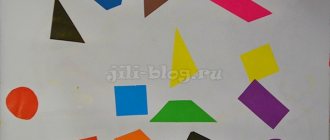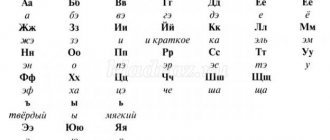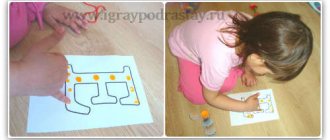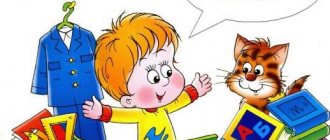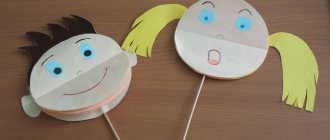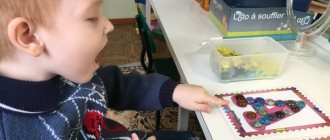Expert Tips: How to Learn the Alphabet
Parents are constantly looking for new, quick ways to learn the alphabet with their child, but fast does not mean quality.
Additional Information! For a comfortable study, you should not forget about the peculiarities of the physiology and psychology of children (age and characteristics of their thinking).
Baby studying
Why teach your child the alphabet?
The alphabet is the basis of all languages. This is a strict sequential construction of letters, which is the key to all documents and books.
Knowing the alphabet will do nothing for a small child. He can easily memorize it, but he will not learn to read. It is better to leave the alphabet for elementary school, where it is needed, and learn the letters with your child without a strict sequence.
At what age should children already know all their letters?
The required level of brain development for reading is usually formed by 5 years, less often by 4-5. Therefore, there is no point in trying to force a child to read at an earlier age. It is better to broaden your horizons, develop speech and pronunciation, teach you how to ask questions correctly and teach you to give answers.
Taking into account age characteristics when learning about letters
In young children, the visual-effective type of thinking dominates, and upon reaching the age of five, the brain will begin to actively perceive iconic images and abstract presentation of information.
Note! By the age of 4, a child must learn basic knowledge for a comfortable future life. He focuses his attention on social connection with the world, so it is not recommended to burden him with unnecessary and complex information, bringing him to tears.
Learning the alphabet
Any activity with your baby is a fun game
Kids cannot concentrate on one activity for more than 10-15 minutes, so the duration should be limited, otherwise attention will be scattered and the child will stop learning new information.
A standard academic lesson is not suitable for children, so you should try to present any learning as an unobtrusive game that will be interesting to him. It is better to use a variety of tasks:
- poetry;
- songs;
- tongue twisters and riddles.
Note! This will provide the child with immersion in the process and facilitate the perception of new knowledge.
How to easily learn the alphabet: basic principles
For each child, you can choose an easy way to learn the alphabet that is suitable only for him, but there are basic principles that are important for all children. If you don’t follow them, studying will turn into drill and the child is unlikely to ever love to read. Here are a few principles on how to properly teach your child the alphabet.
- Learn sounds first, not letters . At the first stage of learning, it does not matter how correctly the letters in the alphabet are called. Now the only sounds that are important for a child are “d”, and not the letter “De”. The names of the letters will only confuse the child, who first needs to learn to recognize the shape of letters and their sounds.
- Not learning the alphabet in the correct order . Until a child goes to school, there is no benefit to him from knowing how the letters are arranged in the alphabet. This information will only distract him from what is really important: what the letters look and sound like. The sequence of the alphabet can be learned later or even at school, where this knowledge will be tested by a teacher.
- Don't turn teaching into a lesson . Studying from bell to bell is difficult even for children at school, let alone a baby. Therefore, all learning should take place in a playful way and not for long: 5–7 minutes a day to become familiar with the letters will be enough. Gradually this time can be increased, especially if the child likes the proposed games with letters.
- Use material objects . At the age of 3–6 years, a child experiences the world by touch and taste. He finds it difficult to work with abstract letters spoken out loud. Therefore, it is better to stock up on plasticine and paints and create letters that are more understandable to the child and can be touched. This game for children will allow the child to learn the letters of the alphabet and he will recognize them in different forms, regardless of what they are made of.
- First the vowels, then the consonants . Vowel sounds are easier to pronounce, so it's worth starting with them.
The main thing is not to force anyone. If you see that the child is inquisitive, enjoys exploring the world and is ready to learn, you can move on to learning letters and the alphabet. This way, the child will enjoy learning the alphabet in a playful way and gradually learn to read.
How to teach a child to memorize letters: techniques
There are many interesting and easy ways and techniques in the world to learn the alphabet. They can be presented both in a classic form and in the form of computer games, modeling or special coloring books.
Letter coloring pages
Classic techniques
The basic option for learning the alphabet is to use cards with letters, syllables and images to consolidate associations and develop visual memory. ABC is also a great option to teach basic literacy.
Note! During learning, you should not rush; if the child is tired or has stopped studying, it is difficult for him to remember new things, it is worth taking a break and returning to this moment later.
First, you should memorize the basic vowels (O, U, A, I), and after that move on to simple consonants (M, N, T, B, P, G). The child must learn to pronounce not the name of the letter, but its pronunciation. That is, not “ZhE” “EN” “BE”, but “LJ”, “NN” and “BB”. You should start learning hissing sounds later, when the baby remembers simpler sounds.
It is necessary to teach letters to study both at home and in the fresh, especially summer air: it is worth getting the child interested in recognizing previously learned letters on children's and adult billboards, signs, and English inscriptions online in games.
Author's methods
All conditions have been created, a large number of proprietary methods to learn letters, sounds and the alphabet. Each method has its own advantages and disadvantages.
Cognitive interest of preschoolers
Important! You should not try to use and combine all methods at once. It is worth focusing on the technique that is comfortable and interesting for the baby to work with.
Learning letters: Polyakov’s game technique
The basis of Polyakov’s method is multiple showing and voicing groups of symbols with their gradual replacement. In the Russian language, groups of rhyming vowels are formed (E-E, A-Ya, O-Yo, Y-I, U-Yu).
The duration of classes is only 7-10 minutes, the frequency is 2 times a week. In your free time, you need to consolidate previously covered material.
This technique uses letter cards and a playful approach, which makes the process easier and more interesting for the child.
Zaitsev cubes
Cubes will help in learning to read from 2 years old. Learning occurs like an exciting game, during which children will begin to read much earlier than they get bored with the activity.
Principles of Zaitsev’s technique:
- Systematic presentation of information.
- Visual presentation of information that uses different channels of perception.
- Presentation of information from specific to general and vice versa.
The main principle of the methodology is teaching not by syllables, but by warehouses. Arrangement is the consonance of a consonant and vowel sound, a separate vowel sound in the form of a syllable or a separate consonant sound in a closed syllable, as well as a consonant with a soft or hard sign.
Doman cards
Doman cards
From birth, the brain is tuned to study and understand the world around us. With this feature, you can begin successful early learning. The technique helps to develop a thirst for knowledge, lays the foundation for a high level of intelligence and helps to learn early reading.
Note! You can use Doman cards for learning from the age of six months.
They represent an image and a word-inscription denoting it. Most often, they are presented in thematic sets.
The sequence is built from simple to complex: it starts with simple words, then phrases and simple sentences are studied, then they move on to common sentences and begin to read.
Methodology of Olga Soboleva
Olga's technique is a creative approach to the process of learning sounds and letters, where the dominant type of memory is involved. The learning process is divided into three information sections for:
- visuals;
- kinesthetics;
- auditory
The learning process is based on a game form with a smooth transition to working with books. It is necessary to help the child love the printed word, and not be afraid of it.
Recommended age for starting classes is 3-4 years.
Alphabet for children - preschoolers
One of the most exciting and interesting moments in the process of teaching a child to read is his introduction to the alphabet. Thanks to the alphabet, the child first becomes acquainted with his native language, letters (sounds).
A child’s knowledge of the letters and sounds that correspond to them is one of the main steps on the path to literacy, education and socialization. Not all parents believe that their children should be taught letters before school, believing that they will learn this at school. But psychologists and teachers believe that it is best to teach a child to read at the age of 4-6, and the alphabet can be learned even earlier.
In fact, there is nothing complicated in the process of teaching a child letters. The main thing is that if you want to get a positive result, you should follow some rules.
One of the most important rules for teaching a child letters is to turn learning the alphabet into an exciting game.
After all, the smaller the child, the more difficult it is for him to maintain attention for a long time. Children get acquainted with the world around them for the first time, study it, and get to know it through play. Therefore, your lessons in learning the alphabet should turn into an interesting game. Children get to know the world around them through their senses - listening and watching.
Therefore, buy for your child something that he will look at with interest, for example: cubes with letters, letter magnets for the refrigerator, letter construction sets, themed coloring books, an alphabet book, an online alphabet. Try to choose colorful, bright manuals and books on teaching reading. When buying an alphabet, try to make the letters in it large. Don't forget to choose the right time to study.
Psychologists and teachers advise working with your child in the afternoon, as productivity is best at this time. Do not demand great results from your child right away; the learning process for all children is purely individual. You can also study letters on the job, walking with your child, being with him in a store, or on a bus; letters can be read on signs or shop windows. Playful methods for learning the alphabet at home include laying out letters together from improvised means, such as pebbles, buttons, and sticks. Development of memory in preschool children.
Alphabet for the youngest children
If you decide to choose an alphabet for your baby. First of all, you must take into account his psychological and age characteristics. The alphabet must be colorful, with large letters.
It is better to start learning the alphabet with vowels. At the same time, it is good to use the child’s associative thinking. So, when studying the letter “A”, show him objects that begin with this letter, but do not forget to show him the letter itself. Once you have learned the vowels, you can move on to the consonants. Learn gradually, for example starting with two letters, and then try to connect consonants with vowels. Even from two letters you can already form simple words. Thus, the child will not only learn letters, but also be aware of their use. As your baby learns the alphabet, you can gradually learn other letters. When learning a letter, tell your child only the sound it stands for: not EL, but L. The child will become familiar with the basics of phonetics at school. Your goal should be to teach your child to recognize letters and the sounds that correspond to them.
An important aspect of learning is the proper organization of time and place for a child’s learning. A small child tends to quickly forget and get distracted. Therefore, you must always consolidate the material you have covered. Again, don’t forget to do this in a playful way. You can ask your child to assemble the word MA-MA from cubes. Don't forget to help your child so that he doesn't lose interest. On our website you will find many exciting and interesting games for teaching reading. Be patient, and you will certainly see the results of your work.
The duration of your lessons depends on the age and individual characteristics of the child. Classes should be interesting and without excessive stress. Little ones are not yet able to concentrate their attention on the same subject for a long time, so the training time should be up to 10-15 minutes. With children 5-7 years old, you can study for half an hour with short breaks - in older preschool age, the child is already more assiduous and collected. But most importantly, classes should be interesting. So only such activities will bring joy and pleasure to your child.
Educational games, letters and alphabet
All parents sooner or later face problems in the process of teaching their child to read. Children are introduced to letters for the first time and try to read. Many parents, especially nowadays, begin to teach their child to read at an early age, when the child is not yet accustomed to studying. In order to achieve results in learning the alphabet, a child must be interested, and an educational game can help with this in the best possible way. To do this, we have developed special educational online games for you to teach reading.
On our website, your child will learn to read from such favorite characters as Masha and the Bear, Luntik, Fixiki, as well as poems by famous children's poets (Agniya Barto, Kirill Avdeev, etc.). In the “Talking Books” section you will find riddles, the alphabet, and tongue twisters for automating sounds.
On our website, your child will not only remember all the letters in a playful way with the help of educational games, but will also learn to read letters. Letters and words are voiced during the game, so it is easier for children to remember them.
Children's alphabet
On our website you will find many interesting and exciting games for learning to read. With the help of our games, your child will quickly and effectively learn all the letters and also learn to read in sequence. The method of teaching reading by letters allows you to bypass two traditional stages in learning at once: you will not need to learn letters separately and then combine them into syllables.
On our website in the “Talking Books” section you will find rhymes about the letters of the alphabet - this is one of the most effective and fun learning options for kids. Your child will be able to prepare for school easily and with interest, and will subsequently write correctly.
Also, riddles, simple rhymes, fairy tales with favorite characters such as Luntik, Masha and the Bear, Fixies offered on our website will help your child consolidate the learned material and diversify the process.
Your child will be interested if during classes you yourself take a direct part, help your child, answer his questions. Speech therapy games for preschoolers help to correctly formulate the sounds of the Russian alphabet. You can play our reading learning games completely free of charge.
All the material on teaching reading on our website is wonderfully illustrated. And cheerful and funny poems by famous poets (Agniya Barto, Kirill Avdeev, Samuil Marshak, etc.) will help your children easily learn and remember the letters of the Russian alphabet.
Educational online games offered on our website will allow your child to master the basics of the Russian language and lay the foundation for successful results at school. The material presented on our website is recommended for teaching children of preschool and primary school age. With the help of these games, your child will easily and simply learn the alphabet.
How to teach a 4 year old child the alphabet at home?
Many parents wonder how to learn the alphabet. There are many ways, but the most effective is learning through interesting games that you will want to return to.
Games for learning the alphabet and numbers
There are many games to help you learn letters and syllables.
Note! You shouldn’t get hung up on one method; the best option would be to combine several types of games so that the learning process remains fun even after several weeks of classes.
Learning by playing
The game form of presenting the material facilitates its easy assimilation. Children love to play, so if you present educational material through games, the child will learn with pleasure.
As a game you can offer your baby:
- modeling;
- coloring books;
- cutting letters from different materials;
- assembly of cut cards with the image of letters.
Let's make letters
Modeling is a very useful learning option. It uses several sensory organs at once and helps in the development of hand motor skills.
Letters can be assembled from different pieces prepared in advance, or they can be folded from long “worms” by assembling and twisting into letters.
Coloring the letters
Coloring can be an excellent teaching material. The alphabet can be presented in the form of pictures or pure images of letters.
Note! If a child has just begun to learn letters, images with letters and pictures will be more suitable for him, and the posted images will help him remember the letters through associations.
Classes on cognitive development in the middle group of preschool educational institutions
Cut out letters from paper
This method will add variety and help develop fine motor skills. It is useful to cut out paper blanks (rectangles, squares and circles) and fold letters from the parts together with your child.
Edible letters
The child will be more interested in the process if learning is associated with positive emotions. Making letters edible is a great way to spice things up.
You can bake cookies together in the form of the alphabet, put together letters and syllables from chopped vegetables, and also draw letters with jam on the surface of pancakes and porridge.
Modeling letters
Techniques to support learning
There are a lot of different techniques, methods and exercises that make learning the letters of the Russian alphabet easy for children. This can include special coloring books, computer games, cutting out letters, sculpting them from plasticine, and even baking.
An original way to memorize letters
You can try this technique: first you need to remember 10 vowel letters, they come in pairs and rhyme, so learning them will be easy: A-Z, U-Y, O-Y, E-E, Y-I. And then move on to consonants, which can also be divided into pairs, for example, voiceless - voiced. There is also a method for learning sounds rather than letters.
One of the most effective ways is singing. You just need to learn a song with the alphabet and hum it constantly. This option is also popular: learning the letters of the Russian alphabet for children aged 5 years not with letters, but immediately with words.
Learning and memorization are best if visual memory is involved. Therefore, it will be very effective to cut out large letters and place them in a constant visibility area so that the child can get used to them and remember them. It is good that they are red, as this color attracts attention. In general, all tools, cards, materials used in teaching should be very bright, colorful, beautiful and attractive in appearance.
Cards for memorizing letters
It has been proven that children remember the alphabet faster and easier if the letters are depicted in the form of an animal. Or when a picture is drawn next to the letter. And then children will associate the letters with a certain image. For example, A with a watermelon or a stork, B with a drum, etc.
If you simultaneously teach your child to write the letters they are learning, the effect will increase many times over.
Tracing and writing letters helps you remember them faster
Just no exams or forced imposition! This should all be interesting to the little one. Let the information flow slowly so that the child does not get confused and refuse to learn. It’s just wonderful if the baby begins to take an interest in letters on his own. And if not, then you need to awaken this curiosity in him. And temporarily postpone classes if interest still does not arise.
Soft toys for learning the alphabet
How to learn the alphabet on your own with a 5-6 year old child?
The age of 5-6 years is optimal to start learning to read. The main thing is to teach him to speak correctly so that the teacher does not have to reteach him. The same exercises are suitable for training as for three to four years old.
Game method for learning 10 vowels in 5 lessons
This technique was proposed by Glen Doman.
Note! It is based on repeated display and sounding of groups of symbols with their gradual replacement. For this purpose, special cards are issued, which are divided by topic.
The process is divided into 5 lessons:
- Studying pairs of vowels (A-Z, O-Y) using easy verses - “This is A”, “This is I”. After the first lessons, it is necessary to consolidate the material, and only then move on to the next step.
- Study of the first three vowels (A-Z, O-Y, U-Y) using the same verses. The first three letter pairs are shown to the child, and the remaining two are pronounced independently so that he does not make a mistake.
- Study of three pairs of vowels (O-Yo, U-Yu, Y-I). From this moment, after adding a new pair, one of the old pairs is removed. The total number of letters represented must be no more than six. The first 4 letters are voiced by the baby, and the remaining 2 are named by the adult, not allowing anyone to make a mistake.
- By the fourth lesson, vowel pairs are memorized (A-Z, O-Y, U-Y, Y-I). Afterwards, the last learned vowels (Y and I) are consolidated.
- By the fifth lesson, all 10 vowels are memorized; all that remains is to consolidate the last learned vowels (E and E).
"Talking ABC"
Game method for teaching consonants
The following games are good for learning consonants:
- Houses. Prepare two houses for consonants and vowels. The letters must be attached to the corresponding house, while simultaneously pronouncing their sounds
- Guests. The same two houses are used. The letters decided to get to know each other. For example, the sound “G” came out first and decided to call the sound “A” for a walk. They pronounce the sound of the letters out loud and ask what syllable it will be.
- Ball game. The parent throws the ball to the baby and says the word. The child only catches words that begin with a vowel or consonant. The second version of the game is for an adult to throw a ball, saying “vowel” or “consonant.” The child names a word that begins with a vowel or consonant.
Putting the letters in order
Arranging letters in alphabetical order is one of the final stages of learning. Electronic or paper posters depicting various objects and letters can help.
Note! The use of posters combines visual and associative learning principles, which makes the learning process easier for the child.
Electronic poster “Talking ABC”
The educational sound poster is a great addition to standard alphabet learning techniques.
It combines visual and audio perception, allowing you to learn the letters and sounds of the alphabet, as well as numbers from 1 to 33. The poster features several modes - song, riddle or task, which allows you to diversify the learning process.
The posters differ in sound and pronunciation principles. It is recommended to choose those where there is a pronunciation of letters as sounds.
Learning the alphabet is an important step in the life of every child, which will allow them to gain new knowledge and analyze it. It is worth treating this period with patience and helping your child learn through a playful approach and support.


